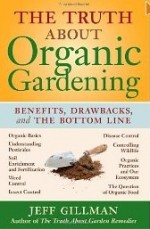 Have you ever noticed that if a product is marked “organic” the price is higher than similar ones? Apparently a lot of people are very attracted to products, especially food, that are associated with organic production. Is this good or bad? Reading Jeff Gillman’s book on the organic gardening debunks some popular myths and clears up some common misunderstanding. In a conversational but informative style, Gillman pushes the gardener to think and evaluate the facts about organic and non-organic practices when making important choices for the garden.
Have you ever noticed that if a product is marked “organic” the price is higher than similar ones? Apparently a lot of people are very attracted to products, especially food, that are associated with organic production. Is this good or bad? Reading Jeff Gillman’s book on the organic gardening debunks some popular myths and clears up some common misunderstanding. In a conversational but informative style, Gillman pushes the gardener to think and evaluate the facts about organic and non-organic practices when making important choices for the garden.
The opening chapter considers the definition of organic gardening and its history. It equates organic gardening to “natural gardening” and points out that people’s concept of natural gardening varies considerably; some people take this concept to the extreme while others are more relaxed. There has been no single official approach to organic growing until recently when the U.S. Department of Agriculture began implementing a set of National Organic Program Standards for farmers producing food to sell to other people. These regulations, of course, are not meant for the home gardeners but the fact that there are now some federal standards will bring some uniformity to the concept of organic gardening.
The bulk of the book is devoted to discussing the pros and cons of various organic and non-organic methods of soil enrichment, and controlling weeds, insects, diseases and animals. Specific control measures are mentioned for each problem and evaluated. The benefits, drawbacks, and “bottom line” are clearly summarized at the end of each entry. You could skip the text and just read the summaries, but that would be a mistake. If you want to understand why some methods are more efficacious than others, and which methods might be more suitable for specific situations, read the whole entry.
Don’t expect Gillman to condemn non-organic herbicides, pesticides, or fertilizers; he doesn’t. Although he is pro-organic gardening he explains that the proper of use of some non-organic products and methods have their place in the home garden and some of the organic ones do not. He further points out that some of the organic products available such as rotenone are more toxic to humans than non-organic pesticides. The word “organic” does not necessarily mean safe.
The final chapters deal with the relationship of organic gardening to the ecosystem and the production of food and contain some very eye-opening facts that should be considered by people interested in organic gardening. Although synthetic chemicals are stringently regulated to insure safety, the same requirements do not apply to natural compounds. Although we think that organic fertilizers won’t leach or run off and contaminate water supplies, this is not the case. So, is organic gardening really best for the environment? Gillman says definitely yes, but gives some meaningful caveats. In regard to organic food production, he supports it whole-heartedly but points out that marketing techniques have often resorted to fear tactics to persuade people to buy organically grown food. One of Gillman’s biggest gripes with this kind of marketing is that it gives the impression that organically grown food is produced without pesticides and this is not the case. According to Gillman, “If you’re looking for strong health or nutritional reasons to purchase organic food, you’ll need to keep waiting.”
Gillman does not give you definitive organic solutions to gardening problems. Instead, he provides the reader with information so that a gardener realizes that each gardening decision has to be considered in context and based on facts rather than myths. He gives you plenty of facts to think about and throws a whole new light on the concept of organic gardening. One of the most important points the author makes is that gardeners must question the practices they consider using rather than just accept them on the basis of conventional wisdom. In his conclusion, Gillman says “Organic gardening should be about making safe and smart choices…”. That says it all.